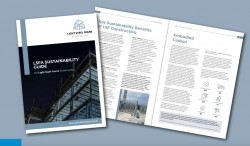As light steel frame technology becomes more widely specified across the UK, members of the Light Steel Frame Association (LSFA), have created a new Sustainability Guide to help demonstrate that it is a highly reliable, robust and sustainable method of construction.
When designers research build systems – fire, thermal and acoustic performance together with structural stability and cost are key drivers. However, the sustainability benefits of light steel systems are not widely understood.
With an objective to support specification through developing a better understanding of the benefits, the LSFA has launched an informative Sustainability Guide to verify the environmental credentials of light steel technology. Timber may have a 'greener' image, but it is well documented that steel is one of the world's most recycled materials with recovery and re-use rates in excess of 90%.
Sustainability is quantified in terms of various measures of environmental, social and economic performance. According to the World Green Building Council, construction and buildings in use are responsible for 39% of all carbon emissions in the world. This is broken down into two elements with 11% being linked to the manufacture of materials and construction processes known as embodied carbon emissions and 28% associated with operational emissions caused by heating, cooling and lighting systems when a building is in use.
Light steel performs well in embodied carbon and operational emission assessments. The key benefits show this to be a construction method which is highly sustainable and suitable for all sectors of the construction industry including residential, commercial, education and healthcare. Light steel technologies include loadbearing and non-loadbearing elements which can be formed from panelised and modular systems or as steel studs for erecting as infill or oversail walling solutions.
The HM Government 'Construction 2025 (July 2013 Report)' stated that the light steel frame sector was: "an industry that has become dramatically more sustainable through its efficient approach to delivering low carbon assets more quickly and at lower cost, underpinned by strong, integrated supply chains and productive longterm relationships."
As time has progressed steel has become part of a carbon neutral solution and sustainability is back at the top of the construction agenda. However, when budgets come into play it is safety, cost, programme, design adaptability and structural integrity which are more often the deciding factors, but the importance of sustainability must not be overlooked when assessing build systems.
The LSFA passionately believe that the answer to complex sustainability questions lie in a lightweight structural response. This is where light steel frame cannot be beaten, with the best strength to weight ratio of all construction materials.
This is particularly relevant when looking at lifecycle analysis including recycling at the end of a building's life which must be factored into any sustainability discussions. The Steel Construction Institute (SCI) publication 'Protocol for Reusing Structural Steel' concludes that the environmental advantages of re-using reclaimed structural steel are considerable, compared to the common practice of recycling by re-melting scrap. There are also potential cost savings to be considered which influence the system selected.
This protocol notes that material characteristics declared under CE marking procedures are designed to ensure that the material is as specified in design. When using reclaimed steel, the design is based on the material properties (tested or conservatively assumed), maintaining the relationship between design assumptions and material resistance. It is therefore appropriate that re-fabricated, reclaimed structural steelwork may be CE Marked in accordance with EN 1090, which demonstrates its suitability for re-use.
It is also worth noting that the steel manufacturing environment is more automated than more traditional build technologies and the industry has become incredibly efficient at value engineering and minimising waste through design for manufacture and assembly (DfMA) approaches. This is assisted by the advances in digital engineering with better use of Building Information Modelling (BIM).
The new LSFA Sustainability Guide covers many of these topics in depth and includes sustainability in light steel frame construction, key sustainability benefits, embodied carbon, means of reducing embodied carbon, accommodating environmental enhancements together with sustainability now and in the future. There are also references for further reading which covers the subject of sustainability in more detail.
Click here to read the LSFA Sustainability Guide








